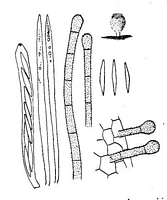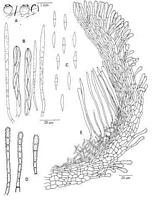|
 Lachnum filiceum Lachnum filiceum
SynonymsDasyscypha filicea
Peziza filicea
BiostatusPresent in region - Indigenous. Endemic
Images (click to enlarge)
Caption: FIG. 8. Dasyscyphus filiceus. Habit sketch x 12, details x 660. | 
Caption: Figure 81. Lachnum filiceum, holotype. A. Apothecia. B. Asci and paraphyses. C.
Ascospores. D. Hairs. E. Vertical section. |
Article: Spooner, B.M. (1987). Helotiales of Australasia: Geoglossaceae, Orbiliaceae, Sclerotiniaceae, Hyaloscyphaceae. Bibliotheca Mycologica 116: 711 p.
Description: APOTHECIA 0.4-0.6 mm diam., stipitate, superficial, scattered or gregarious in small groups.
DISC concave, greyish-white, surrounded by the raised margin and obscured in dried
apothecia. RECEPTACLE translucent, pale grey or olive-grey, urceolate, the margin over-reaching the
disc to constrict the aperture, fringed with whitish hairs, elsewhere clothed with short hairs
which are scarcely visible in rehydrated apothecia but give them a pulverulent appearance
when dried. STIPE cylindric, 100-300 µm high, 100-130 µm diam., also clothed with short
hairs. HAIRS hyaline, cylindric-clavate, obtuse, those at the margin densely set, 50-70 x 4.5-5.5 µm, multiseptate, the walls thickened, granulate except towards the base. Hairs elsewhere
scattered, shorter, 15-30 µm long, usually smooth. ASCI 63-75(-80) x 6-7 µm, 8-spored,
cylindric-clavate, virtually sessile, apex conical, the pore conspicuously outlined blue in
Melzer's reagent. ASCOSPORES 13.5-19.5 x 2.0-3.0, mean 15.8 (SD 1.4) x mean 2.4 (SD
0.2) µm, hyaline, fusoid, acute at the ends, straight, often inequilateral or slightly curved,
frequently becoming 1-septate, biseriate. PARAPHYSES lanceolate, 3.5-4.5 µm, diam.,
septate only towards the base, containing numerous small guttules, exceeding the asci by 15-20 µm. SUBHYMENIUM indistinct. MEDULLARY EXCIPULUM composed in the stipe of
parallel, vertically arranged, hyaline hyphae 2.0-2.5 µm diam., continuing into the receptacle
as a narrow layer of parallel hyphae lying adjacent to the ectal excipulum but becoming
interwoven in the centre of the receptacle in a layer 40-50 µm deep at centre, narrowing
upwards and not differentiated from the ectal layer at the margin. ECTAL EXCIPULUM
indistinct on the stipe, 25-30 µm thick on the receptacle, composed of broad, often
subglobose, thin-walled, hyaline cells 8-15 x 5-12 µm, arranged at the base of the receptacle in
irregular rows at a rather high angle to the surface, becoming narrower and prismatic, 4-5 µm
diam. towards the margin and lying in chains curving round parallel to the surface. Margin
extending beyond the surface of the disc by 70-80 µm.
Habitat: On decaying pinnae of Dicksonia squarrosa Swartz.
Known only from the type collection.
Notes: This distinctive species is in some ways atypical of Lachnum. The margin extends beyond the
surface of the disc to form an urceolate receptacle which narrows upwards to a small, rounded
aperture which is fringed with hairs. The hairs at the margin are densely crowded and, except
near the base, have completely granulate walls. However, elsewhere on the receptacle hairs
are comparatively few and scattered and mostly appear smooth, at least after staining in
Melzer's reagent. The hairs are comparatively short and clavate towards the apex and in form
resemble those of Cistella, though in that genus the hairs are thin-walled, not more than 2-septate and have granulation confined to the apical region.
The structure of the ectal excipulum is also atypical of Lachnum, being composed in the
lower receptacle of broad cells in irregular rows at a rather high angle to the surface.
However, nearer the margin, the cells lie in more regular chains, parallel to the surface and
characteristically prismatic. The asci and lanceolate paraphyses are quite typical of Lachnum
and this seems the most appropriate genus in which to place this species.
The report of "Peziza filicea" from Cheddar (England. Somerset) by Bucknall (1882)
was repeated by subsequent authors such as Phillips (1887), Saccardo (1889) and Massee
(1895), and is the sole basis for inclusion of this species in check-lists of British discomycetes.
However, re-examination of the Bucknall collection, preserved at Kew, shows this to be based
on an error in identification. This collection consists of portions of a frond of Pteridium
aquilinum bearing, on the undersurface of the pinnules, minute yellowish apothecia referable to
Hyaloscypha flaveola (Cooke) Nannf. There are no subsequent reports of Peziza filicea from
Britain, and a later collection under this name in Kew, from Lyndhurst, Hampshire ex Herb.
Massee, is on an herbaceous stem and referable to Cistella grevillei (Berk.) Massee.
Article: Dennis, R.W.G. (1961). Some inoperculate Discomycetes from New Zealand. Kew Bulletin 15(2): 293-320.
Description: Apothecia scattered, superficial, cupshaped with short cylindrical stalks, up to about 1 mm.
diameter, white throughout, clothed with cylindrical, obtuse, often slightly capitate, thin-walled, septate, hyaline, finely granulate hairs which are 25-35 x 3-3.5 µ on the flanks but up
to 75 x 5.5 µ at the margin. Asci cylindric-clavate, pore blued by Melzer's reagent, 8-spored,
70 x 6 µ; ascospores irregularly biseriate, fusoid, 14-18 x 2-2.5 µ; paraphyses lanceolate, up to
3 µ wide, with oily contents, protruding about 10 µ beyond the asci.
Article: Saccardo, P.A. (1889). Discomyceteae et Phymatosphaeriaceae. Sylloge Fungorum 8: 3-859 Padua: (http://194.203.77.76/LibriFungorum/Search.asp?ItemType=I).
Habitat: in Filicibus, Dunedin et Chedder Britanniae.
Notes: Pili septati, leves, apice granuloso-capitati.
Article: Cooke, M.C. (1879). New Zealand fungi. Grevillea 8(46): 54-68.
Notes: The hairs are septate, smooth, and granularly capitate.
|